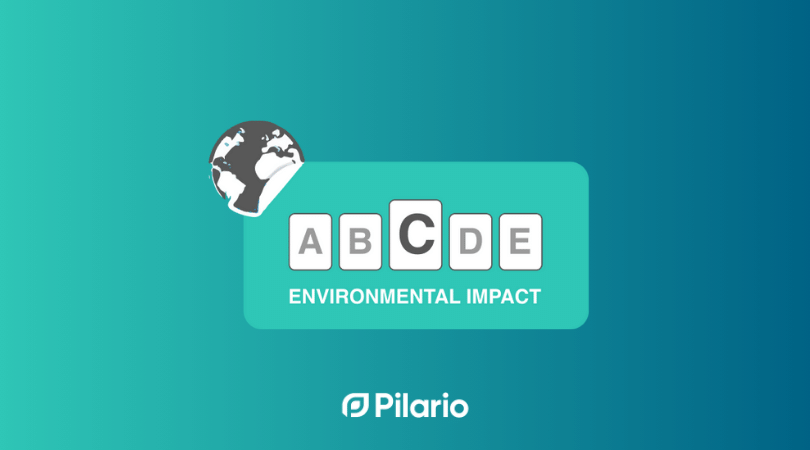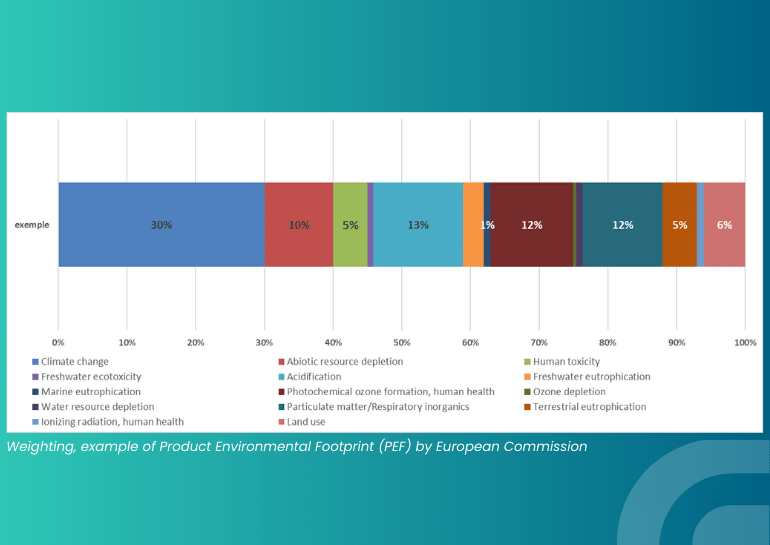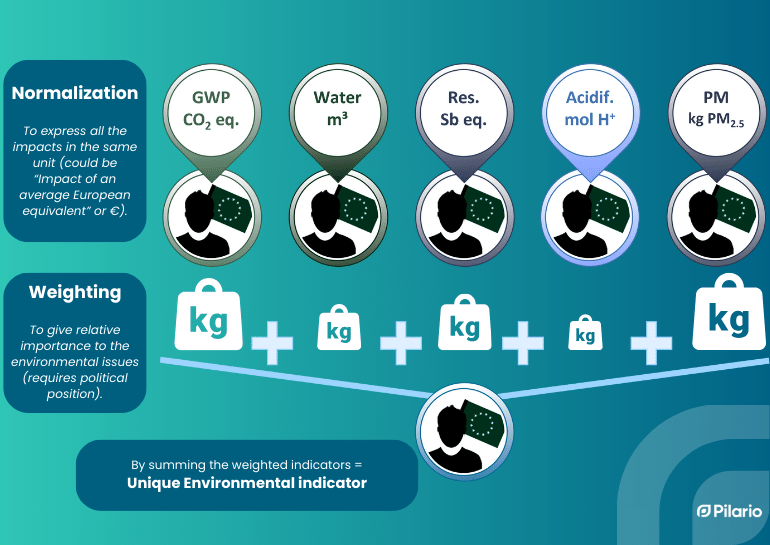08/03/2024
How PEFCR Standardizes Sustainability: A Deep Dive into Product Environmental Footprint Category Rules
Discover how to navigate and benefit from Product Environmental Footprint Category rules in our in-depth guide.

4 April 2024
In this article, we delve into the world of Life Cycle Assessment (LCA) and its pivotal role in sustainable product development. Through an exploration of how LCA impact scores quantify a product’s environmental footprint, we unveil what the environmental single score actually is.
Discover the methodical process behind calculating these scores, their significance in highlighting sustainability improvements, and the challenges of benchmark comparison. Learn how Pilario, our LCA solution, empowers businesses to navigate these complexities, simplifying LCA analysis to enhance eco-friendly innovation and market leadership.
Life Cycle Assessment (LCA) is a key instrument for supporting sustainable product development, offering a thorough method to evaluate the environmental consequences at every phase of a product’s life cycle. This includes everything from the extraction of raw materials, through processing, manufacturing, distribution, and usage, as well as repair, maintenance, and eventually disposal or recycling (often summarized as “from cradle to grave”), embodying a comprehensive LCA footprint. By adopting this complete approach, both enterprises and consumers may make decisions that promote environmental sustainability.
Central to the LCA methodology, LCA impact scores precisely measure a product’s environmental footprint across multiple categories, including greenhouse gas emissions, water usage, energy consumption, among others. These scores play a pivotal role in highlighting areas where a product’s environmental performance can be enhanced, offering a metric-based evaluation that supports product comparison and the identification of sustainability improvements.
The calculation of LCA scores involves a detailed and methodical process, integral to LCA impact assessment of a product across its entire lifecycle. This assessment is broken down into four key phases as outlined by the International Organization for Standardization (ISO) standards ISO 14040 and 14044:
At the core of this approach are LCA scores, indicators, and impact categories, along with the crucial steps of normalization and weighting. Let’s unpack these concepts to see what they really mean for your product.
LCA evaluates a product’s environmental impact across various impact categories such as climate change, water depletion, and biodiversity loss. The PEF project decided to assess those impact categories through 16 LCA indicators. Specific LCA indicators assess each category. These indicators act as metrics that reflect the extent of a product’s environmental impact. For instance, reducing water use improves the water depletion indicator but might negatively affect another category. This highlights the interconnected nature of environmental impacts.
The process of normalization addresses this challenge by converting diverse environmental impacts into a common unit, the very first step to enable comparisons. After this, the process of weighting gives different levels of importance to these impacts. It follows certain standards but also involves personal opinions or public policies. This step underscores the complexity of valuing different environmental issues against each other. The Product Environmental Footprint (PEF) offers a visualization of priorities, but also highlights the inherent subjectivity in determining the significance of one environmental issue over another.

All these efforts culminate in the Unique Environmental Indicator, which sums up all the weighted impacts into a single, comprehensive indicator. This score intends to offer a snapshot of a product’s overall environmental performance. These provide a baseline for meaningful comparisons.

LCA scores are instrumental in evaluating and comparing the environmental performance of products. By offering a relative ranking system, they highlight areas where products can be improved to reduce their environmental footprint. However, the effectiveness of LCA scores hinges on the ability to compare them against well-defined, industry-accepted benchmarks. When such benchmarks are in place, LCA scores become a powerful tool for driving product innovation and sustainability.
Moreover, LCA scores can influence market dynamics by informing consumers about the sustainability of products. Products with better environmental performance can differentiate themselves in the market, appealing to the growing demographic of eco-conscious consumers. This market pressure, in turn, encourages companies to adopt more sustainable practices across their product lines.
Finding an appropriate reference product presents a key challenge in evaluating the so-called “ABC” scoring within Life Cycle Assessment (LCA). It is typically categorized as A, B, C, D, E, with “C” indicating that the assessed product has the same environmental performance as the reference. A score of “E” indicates a worse impact. This benchmarking is crucial for effective product comparison. It shows how a product’s environmental impact compares to the market average, through the ABC score.
Sector-specific guidelines, like those provided by the Product Environmental Footprint Category Rules (PEFCR), could help to make this process uniform by establishing common reference products and methods for assessing environmental impacts. Nevertheless, today there is no abroad consensus on the method to evaluate the ABC scoring.
While LCA scores provide valuable insights into a product’s environmental performance, it’s essential to consider the broader footprint. This encompasses not only the direct impacts measured by LCA scores but also indirect effects such as social and economic implications of sustainability practices. As we look to the future, it’s crucial to continue refining sustainability assessment methodologies to capture these broader impacts more accurately.
Emerging technologies and data analytics offer promising avenues for enhancing the precision and applicability of sustainability assessments. By leveraging these tools, businesses can gain deeper insights into their products’ sustainability and identify new opportunities for improvement. Moreover, a collaborative approach to sustainability, involving industry-wide standards and consumer education, will be key to maximizing the impact of LCA in driving the global transition to a more sustainable future.
Life Cycle Assessment (LCA) and its impact scores are crucial for eco-friendly product development, guiding us to make environmentally sound decisions. However, the true power of LCA scores depends on comparing them with industry-recognized benchmarks. Without these benchmarks, it’s tough to fully harness LCA’s comparison potential for fostering product innovation and sustainability.
This is where Pilario shines. Our LCA solution fills the gap by providing easy-to-use LCAs that help businesses align with these essential benchmarks. With Pilario, you’re equipped with industry-specific, compliant LCA models, simplifying the integration of sustainability into your business practices. Whether you’re an LCA expert or a business leader aiming for a green transformation, Pilario is designed to support your journey towards sustainability. And with our benchmark features, Pilario empowers you to effortlessly align your product with the sector’s official reference standards. By opting in, you also gain insights into how your product stands relative to the evolving average on our platform, ensuring your sustainability efforts are both competitive and compliant, with full control over your data sharing preferences.
Interested in leveraging LCA for your product’s advantage? Book a demo with one of our experts now and take a significant step toward sustainable product development.

08/03/2024
Discover how to navigate and benefit from Product Environmental Footprint Category rules in our in-depth guide.

07/03/2024
Unlock the EU's Product Environmental Footprint secrets: Drive sustainable choices and green innovation.

22/09/2023
Unlock sustainable success with LCA, PEF, and PEFCR. Understand environmental impacts, gain trust, and comply with EU standards effortlessly.

26/01/2024
Uncover the difference between LCA and carbon footprint. Embark on a journey of sustainability with our expert guide!